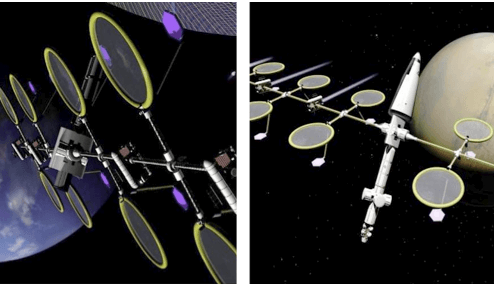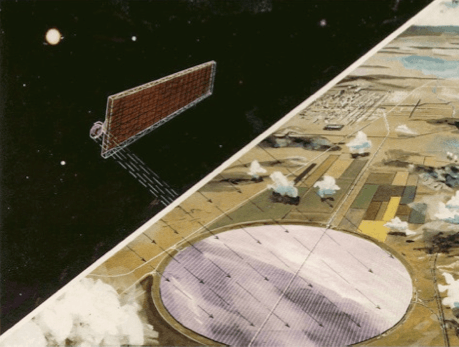Space Solar Power Only Ten Years Away
November 15, 2011
on
on

Harvesting solar energy in space could provide the world’s need for energy in thirty years, a report of the IAA says. The first Solar Power Satellites could be orbiting the earth in ten years.
Space Solar Power (SSP) can be captured by bringing Solar Power Satellite (SPS) systems in orbit over the equator. Each SPS is several kilometers wide and is exposed to the sun 24/7.
The solar energy is converted to electricity in space and beamed to earth over a microwave radio frequency. Ground based antenna’s act as receivers for the transmitted power and feed the electricity into the grid.
The technology could be up and running in ten years, deliver substantial quantities of energy in twenty and be cost-effective in thirty.
The International Academy of Astronautics (IAA) is a non-governmental organization which promotes international collaboration to further the development of astronautics for peaceful purposes. The report Space Solar Power reflects the final findings of a three-year assessment of the SSP study group. It contains an evaluation of SSP technologies, an assessment of policy issues and explores prospective markets
In the chapter on policies and regulations the study group assesses existing international space agreements and its impact on future SSP projects. The Outer Space Treaty of 1967, for instance, states that ‘All space activities must be carried out for the benefit and in the interests of all Countries and shall be the province of all mankind.’ From this follows that any SSP development must benefit all countries.
The Treaty also states that ‘A Country must not appropriate space by any means.’ Which could prove problematic for executing SSP projects because ‘[T]he capture of solar energy in space would not be considered as “appropriation”. However, the long-term placement of SPS in GEO slots might very well be considered as a de facto appropriation.’, the report states.
The study group also explores the question whether SSP complies with sustainable energy policies. To determine if an energy source is sustainable the 'energy payback time' (EPT) is calculated: the time it takes for the system to generate the energy that was initially needed to manufacture and deploy the system. Earth based photovoltaic systems have an average EPT of three years. SSP systems are estimated to have a EPT of 1 year or less. Consequently SSP could contribute to reducing and/or mitigating the risks of climate change.

Another big question is who is willing to pay for the energy generated by SSP. In the previous decades the prospects weren’t good. Between the 1960’s and the 1990’s several studies conducted by space agencies like NASA, concluded that SSP would not be a viable investment. For SSP to earn its keep it would have to compete with fossil fuels in price and guarantee a 30% return on investment. Because of the low price of fossil fuels and the cost-intensive nature of space technology, it was never a compatible technology.
But times have changed. The depletion of fossil fuels is driving up its prices while policy incentives bring the price of renewable energy down. The pendulum is swinging the other way.
The report Space Solar Power, The First International Assessment Of Space Solar Power: Opportunities, Issues And Potential Pathways Forward is downloadable at iaaweb.org [PDF]
Photos: NASA Artwork: SPS systems by Pat Rawlings; Beaming electricity to earth by DEO Artwork
Via physorg.com
Space Solar Power (SSP) can be captured by bringing Solar Power Satellite (SPS) systems in orbit over the equator. Each SPS is several kilometers wide and is exposed to the sun 24/7.
The solar energy is converted to electricity in space and beamed to earth over a microwave radio frequency. Ground based antenna’s act as receivers for the transmitted power and feed the electricity into the grid.
The technology could be up and running in ten years, deliver substantial quantities of energy in twenty and be cost-effective in thirty.
The International Academy of Astronautics (IAA) is a non-governmental organization which promotes international collaboration to further the development of astronautics for peaceful purposes. The report Space Solar Power reflects the final findings of a three-year assessment of the SSP study group. It contains an evaluation of SSP technologies, an assessment of policy issues and explores prospective markets
In the chapter on policies and regulations the study group assesses existing international space agreements and its impact on future SSP projects. The Outer Space Treaty of 1967, for instance, states that ‘All space activities must be carried out for the benefit and in the interests of all Countries and shall be the province of all mankind.’ From this follows that any SSP development must benefit all countries.
The Treaty also states that ‘A Country must not appropriate space by any means.’ Which could prove problematic for executing SSP projects because ‘[T]he capture of solar energy in space would not be considered as “appropriation”. However, the long-term placement of SPS in GEO slots might very well be considered as a de facto appropriation.’, the report states.
The study group also explores the question whether SSP complies with sustainable energy policies. To determine if an energy source is sustainable the 'energy payback time' (EPT) is calculated: the time it takes for the system to generate the energy that was initially needed to manufacture and deploy the system. Earth based photovoltaic systems have an average EPT of three years. SSP systems are estimated to have a EPT of 1 year or less. Consequently SSP could contribute to reducing and/or mitigating the risks of climate change.

Another big question is who is willing to pay for the energy generated by SSP. In the previous decades the prospects weren’t good. Between the 1960’s and the 1990’s several studies conducted by space agencies like NASA, concluded that SSP would not be a viable investment. For SSP to earn its keep it would have to compete with fossil fuels in price and guarantee a 30% return on investment. Because of the low price of fossil fuels and the cost-intensive nature of space technology, it was never a compatible technology.
But times have changed. The depletion of fossil fuels is driving up its prices while policy incentives bring the price of renewable energy down. The pendulum is swinging the other way.
The report Space Solar Power, The First International Assessment Of Space Solar Power: Opportunities, Issues And Potential Pathways Forward is downloadable at iaaweb.org [PDF]
Photos: NASA Artwork: SPS systems by Pat Rawlings; Beaming electricity to earth by DEO Artwork
Via physorg.com
Read full article
Hide full article


Discussion (2 comments)